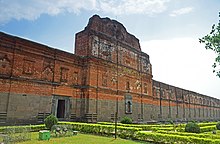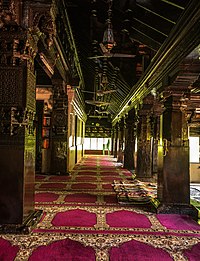Muslim period in the Indian subcontinent
| Part of a series on |
| Islam in India |
|---|
 |
Muslim period in the Indian subcontinent is conventionally said to have started in 712, after the conquest of
From the late 12th century onwards, Muslim empires dominated the subcontinent, most notably the
The height of Islamic rule was marked during the reign of
In the 18th century the Islamic influence in india begin to decline following the
Throughout the 18th and 19th centuries, large parts of India were colonized by the
Today,
History
Early Muslim dominions
Local kings who converted to
Delhi Sultanate

The Delhi Sultanate was the first of the two major Islamic empires which was based in mainland India between 1206 and 1526. It emerged after the disintegration of the
The Delhi sultanate peaked under
Both the


Mughal Empire
The
India was producing 24.5% of the world's manufacturing output up until 1750.[20] Mughal economy has been described as a form of proto-industrialization, like that of 18th-century Western Europe prior to the Industrial Revolution.
After the death of Aurangzeb, the empire declined and reduced subsequently to the region in and around Old Delhi by 1757 to 1760. The decline of the Mughals in the 18th century provided opportunity for the
Western and central India
Sultan Alauddin Khalji (r.1296–1316) carried out extensive conquests in the western India. He invaded the kingdoms of Gujarat (raided in 1299 and annexed in 1304), Jaisalmer (1299), Ranthambore (1301), Chittor (1303), Malwa (1305), Siwana (1308), and Jalore (1311). These victories ended several Rajput and other Hindu dynasties, including the Paramaras, the Vaghelas, the Chahamanas of Ranastambhapura and Jalore, the Rawal branch of the Guhilas, and possibly the Yajvapalas; and permanently establishing Muslim rule in the regions of central and western India. After his death, independent Islamic kingdoms emerged there.
Gujarat Sultanate
The

Malwa Sultanate
The
Other Western states
Sindh was ruled by a series of Muslim dynasties including Habbaris, Soomras, Sammas, Arghuns and Tarkhans, after the disintegration of Arab caliphate. Following decline of Mughal empire, Kalhora and Talpur Nawabs ruled Sindh. Kingdom of Mewat was also a prominent Muslim Rajput kingdom in Rajasthan.Gonds of Deogarh was also a Gond/tribal Islamic kingdom located in Nagpur,Maharashtra.
North India
Bengal Sultanate
In 1339, the Bengal region became independent from the
Although a

Persian was used as a diplomatic and commercial language. Arabic was the liturgical language of the clergy, and the
The
Jaunpur Sultanate
The
Nawabs of Bengal
Nawab was a title given by the Mughals to the governors of different provinces. During disintegration of the empire in the 18th century, many Nawabs became de facto independent.
In the early 18th-century, the
Nawabs of Awadh
Nawab of Awadh ruled major parts of present-day Uttar Pradesh. The Nawabs of Awadh, along with many other Nawabs, were regarded as members of the nobility of the greater Mughal Empire. They joined Ahmad Shah Durrani during the Third Battle of Panipat (1761) and restored Shah Alam II (r. 1760–1788 and 1788–1806) to the imperial throne. The Nawab of Awadh also fought the Battle of Buxar (1764) preserving the interests of the Moghul. Oudh State eventually declared itself independent from the rule of the "Great Moghul" in 1818.[35]
Oudh joined other Indian states in an upheaval against British rule in 1858 during one of the last series of actions in the
Other Northern states
In northern India, the Multan-based
South India
Till the early 14th century, south India was ruled by Hindu dynasties. During the reign of
Bahmani Sultanate

The Muhammad bin Tughlaq's failure to hold securely the Deccan and South India resulted in the rise of competing for Southern dynasties: the
Deccan sultanates
The Bahmani Sultanate lasted for almost two centuries, until it fragmented into five smaller states, known as the

The rulers of the Deccan sultanates made a number of cultural contributions in the fields of literature, art, architecture, and music. An important contribution was the development of the
When the rulers of the five
Nizams of Hyderabad
The dynasty ruled for 7 generations, with the last Nizam – Mir Osman Ali Khan showing an enormous contributions on the field of education, construction of major public buildings across the kingdom, setting up of Nizam's Guaranteed State Railway(NSGR), donations to Universities, temples[43] and donating 14,000 acres (5,700 ha) of land from his personal estate to Vinobha Bhave's Bhoodan movement.[44]
Mysore Kingdom

Carnatic Sultanate
The Carnatic Sultanate was a kingdom in South India between about 1690 and 1855, and was under the legal purview of the Nizam of Hyderabad, until their demise.[45][46] The Nawabs of Carnatic eventually ceded tax rights to the British in 1801 following Carnatic wars, and the kingdom was abolished.
Other Southern states
Other southern states include the
See also
Literature
- Majumdar, Ramesh Chandra; Pusalker, A. D.; Majumdar, A. K., eds. (1960). The History and Culture of the Indian People. Vol. VI: The Delhi Sultanate. Bombay: Bharatiya Vidya Bhavan.
- Majumdar, Ramesh Chandra; Pusalker, A. D.; Majumdar, A. K., eds. (1973). The History and Culture of the Indian People. Vol. VII: The Mughal Empire. Bombay: Bharatiya Vidya Bhavan.
- Elliot, Sir H. M., Edited by Dowson, John. The History of India, as Told by Its Own Historians. The Muhammadan Period; published by London Trubner Company 1867–1877. (Online Copy: The History of India, as Told by Its Own Historians. The Muhammadan Period; by Sir H. M. Elliot; Edited by John Dowson; London Trubner Company 1867–1877 – This online Copy has been posted by: The Packard Humanities Institute; Persian Texts in Translation; Also find other historical books: Author List and Title List)
References
- ^ Tripathi, R. P. (1956). Some Aspects of Muslim Administration. Allahabad: Central Book Depot. p. 24.
- ISBN 978-0-557-00033-3. Archivedfrom the original on 2 May 2021. Retrieved 1 December 2021.
- ISBN 978-93-82573-47-0. Archivedfrom the original on 26 April 2021. Retrieved 1 December 2021.
- ISBN 978-81-7156-017-2.
- ISBN 9781783475728.
- ISBN 9788185220383.
- ISBN 978-81-321-0769-9. Archivedfrom the original on 5 May 2021. Retrieved 1 December 2021.
- ISBN 978-0-415-58061-8. Archivedfrom the original on 11 April 2023. Retrieved 1 December 2021.
- ISBN 978-0-87586-438-9. Archivedfrom the original on 21 November 2021. Retrieved 1 December 2021.
- ISBN 978-0-7864-9470-5. Archivedfrom the original on 4 May 2021. Retrieved 1 December 2021.
- ISBN 978-0-8264-1815-9. Archivedfrom the original on 2 May 2021. Retrieved 1 December 2021.
- ISBN 978-0-429-97340-6.
- ISBN 9781107007857.
- ISBN 978-0520325128.
The career of Khizr Khan, a Punjabi chieftain belonging to the Khokar clan...
- ISBN 978-1-108-41774-7. Archivedfrom the original on 5 April 2023. Retrieved 19 March 2023.
- ISBN 978-0-19-922720-4.
- ^ Madison 2007, p. 376.
- ^ Pacey, Arnold (1991) [1990]. Technology in World Civilization: A Thousand-Year History. The MIT Press. p. 10.
- ISBN 9781441151278. Archivedfrom the original on 14 November 2020. Retrieved 2 January 2015.
- ^ Jeffrey G. Williamson & David Clingingsmith, India's Deindustrialization in the 18th and 19th Centuries Archived 29 March 2017 at the Wayback Machine, Global Economic History Network, London School of Economics
- ISBN 978-90-04-13561-1.
Similarly, Zaffar Khan Muzaffar, the first independent ruler of Gujarat, was not a foreign Muslim but a Khatri convert, of a low subdivision called the Tank, originally from southern Punjab.
- ISBN 978-90-04-08112-3.
- ^ "Gaur and Pandua Architecture". Sahapedia. Archived from the original on 13 November 2020. Retrieved 12 February 2020.
- ISBN 978-1-139-50257-3.
- ISBN 978-0-520-20507-9. Archivedfrom the original on 22 October 2023. Retrieved 12 February 2020.
- ^ Bar chart race: the most populous cities through time, archived from the original on 12 December 2021, retrieved 22 December 2019
- ^ Kapadia, Aparna (30 March 2019). "Gujarat's medieval cities were once the biggest in the world – as a viral video reminds us". Scroll.in. Archived from the original on 8 November 2020. Retrieved 22 December 2019.
- ^ "Evolution of Bangla". The Daily Star. 21 February 2019. Archived from the original on 11 September 2020. Retrieved 31 December 2019.
- ISBN 978-1-84774-059-5.
- ISBN 978-0-520-20507-9. Archivedfrom the original on 6 January 2017.
- ^ Abdul Karim. "Ghiyasia Madrasa". Banglapedia: National Encyclopedia of Bangladesh. Asiatic Society of Bangladesh. Archived from the original on 8 August 2016. Retrieved 12 February 2020.
- ^ "Jalaluddin Muhammad Shah". Banglapedia. Archived from the original on 7 July 2015.
- ^ "Bengal | region, Asia". Encyclopædia Britannica. 2 December 2023. Archived from the original on 19 October 2021. Retrieved 26 January 2023.
- ^ "Odisha – History". Encyclopædia Britannica. 3 December 2023. Archived from the original on 28 September 2021. Retrieved 26 January 2023.
- ^ "As children, we wanted revenge on the British". The Times of India. 30 September 2016. Archived from the original on 9 May 2019. Retrieved 13 April 2019.
- ISBN 0-330-02524-4
- ISBN 978-0-521-25484-7. Archivedfrom the original on 11 April 2023. Retrieved 19 March 2023.
- ^ "The Five Kingdoms of the Bahmani Sultanate". orbat.com. Archived from the original on 23 February 2007. Retrieved 5 January 2007.
- ISBN 9781438129167.
- ^ a b Yazdani, Ghulam (1947). Bidar, Its History and Monuments. London: Oxford University Press. pp. 114–142.
- .
- ^ "Deccani painting". Encyclopedia Britannica. Archived from the original on 27 January 2019. Retrieved 27 January 2019.
- ^ "Nizam Hyderabad Mir Osman Ali Khan was a perfect secular ruler". The Siasat Daily – Archive. 13 August 2015. Archived from the original on 17 September 2018. Retrieved 8 September 2022.
- ^ Sunil, Mungara (4 September 2016). "Much of Bhoodan land found to be under encroachment in city". The Times of India. TNN / Updated. Archived from the original on 13 October 2022. Retrieved 5 September 2022.
- ISBN 9781615302017.
- ISBN 9780836412628.
 This article incorporates text from this source, which is in the public domain. Country Studies. Federal Research Division. – India, Pakistan
This article incorporates text from this source, which is in the public domain. Country Studies. Federal Research Division. – India, Pakistan

